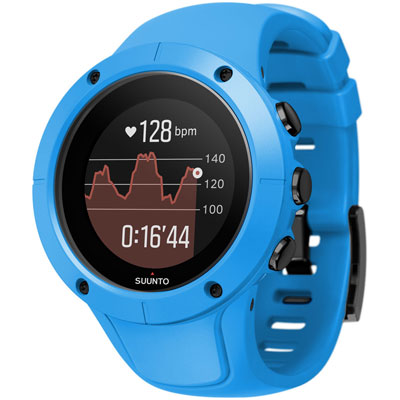
The Suunto Spartan Trainer Wrist HR is Suunto’s latest addition to their training watch range, and their latest attempt at the world record for longest product name in the world (from now on I’ll be calling it the Spartan Trainer!). The Spartan Trainer is a trimmed down version of their Spartan Sport Wrist HR. For £219.00 or £279.00 (depending whether you want a metal bezel and hardened glass screen) you get a lot of watch! It features everything you need for recording daily activity and detailed performance monitoring of specific sports. GPS, Integrated wrist HR monitor the ability to record up to 20 different activity, and integrated multi sport events like triathlon, all fully customisable through Suunto’s Movescount app.
Looking at the Trainer you may be thinking, hang on isn’t that an Ambit 3? It does look very similar to an Ambit 3 with the same button lay out (no touch screen like the rest of the Spartans) and the same bar GPS antenna below the watch face. However the Trainer is actually slightly smaller than the Ambit 3 which is great for those of us with smaller wrists, and for wearing as an everyday watch. The buttons functions are different to those on the Ambit as they have to work with the Spartan operating system.

The main feature which separates the Trainer from the majority of Suunto’s range of sports watch is the addition of the integrated heart rate monitor on the back of the watch. While optical HR monitors are convenient as you do not have to bother with a chest strap, their accuracy has always been questionable. Suunto have a reputation for durability and dependability to maintain so they have partnered with the industry leading Valencell to produce an optical monitor which they claim delivers data accurate to within 5 percent of a chest strap, 89 percent of the time. For Tri and swim activities the Trainer is still compatible with the Suunto Smart Sensor HR chest strap.

The Spartan Trainer comes with 17 sport modes installed on the watch with the option to add 3 more. Each sport mode is customizable with the ability to display up to 7 fields of data on each screen as the watch is recording. The depth of data recording available straight away is pretty impressive, each sport mode is further subdivided in to sub categories, Run for example is divided into:
Basic – Designed for running outdoors with heart rate. This mode automatically creates 1 km (1 mile) splits. Laps can be compared in real time with average pace, heart rate and cadence. The breadcrumb view helps you track back to your starting point.
Power – Designed for running with a power meter. Track your power values with pace and heart rate. With 1 km (1 mile) autolaps, you can compare your running power and pace for each lap.
Interval – Designed for interval running. Use the lap table view to compare intervals with duration, average heart rate and max heart rate. This mode stores the run with the Move type ‘interval’ so you can follow your progress over time.
Race – Designed for running a marathon or test run of any distance. Set a target distance and/or duration to follow your progress during the race in real time. Autolaps of 1 km (1 mile) give you regular alerts. This mode stores the run with Move type ‘race’ so you can compare your race performances over time.
Track – Designed for running on a track indoors or outdoors without GPS. Provides you with key values based on heart rate. Manually create laps to follow your progress. Also track speed and distance when used together with a compatible foot POD.
You can also add your own sub categories to record whatever you like.
The navigation screen will display a breadcrumb trail of your current activity so if you get lost you can always follow it back home! Or you can add a route which you have pre-planned and the trail will show you current location on that route. The GPS antenna picks up a signal very quickly, I never had to wait more than 30 seconds when recording an activity or using the show my location function in the navigation screen. This was straight out of the box, with use and a new update the GPS fixing becomes much faster.
Cramming all these features into a watch which is smaller and cheaper than the rest of Suunto’s range some sacrifices would obviously have to be made. Luckily this is only in one area, the battery life. While recording at maximum accuracy with GPS recording intervals of 1 second the Trainer will keep going for roughly 8 hours. This can be improved by reducing the recording intervals. As just a timepiece the watch will last roughly 14 days between charges. This battery life is much lower than the regular Spartan at 100 hours with max recording intervals but is totally fine as a training watch and is actually comparable with other watches in and above its price bracket.
Despite a pretty cumbersome name the Spartan Trainer is a very sleek sports watch offering a massive amount features for a very reasonable price. If you are in the market for an upgrade of your current sports watch or looking for your first plunge into the world of data obsession the the Trainer should be top of your list.

